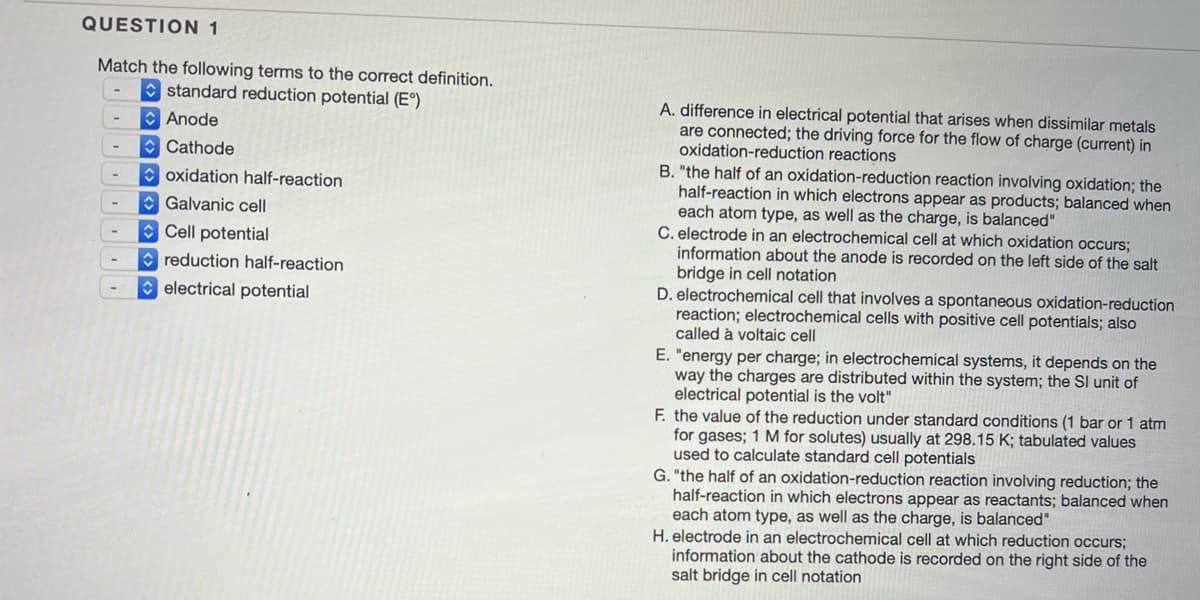Match the following terms to the correct definition. - standard reduction potential (E°) Anode Cathode oxidation half-reaction Galvanic cell Cell potential reduction half-reaction electrical potential - - - A. difference in electrical potential that arises when dissimilar metals are connected; the driving force for the flow of charge (current) in oxidation-reduction reactions B. "the half of an oxidation-reduction reaction involving oxidation; the half-reaction in which electrons appear as products; balanced when each atom type, as well as the charge, is balanced" C. electrode in an electrochemical cell at which oxidation occurs; information about the anode is recorded on the left side of the salt bridge in cell notation D. electrochemical cell that involves a spontaneous oxidation-reduction reaction; electrochemical cells with positive cell potentials; also called à voltaic cell E. "energy per charge; in electrochemical systems, it depends on the way the charges are distributed within the system; the SI unit of electrical potential is the volt" F. the value of the reduction under standard conditions (1 bar or 1 atm for gases; 1 M for solutes) usually at 298.15 K; tabulated values used to calculate standard cell potentials G. "the half of an oxidation-reduction reaction involving reduction; the half-reaction in which electrons appear as reactants; balanced when each atom type, as well as the charge, is balanced" H. electrode in an electrochemical cell at which reduction occurs; information about the cathode is recorded on the right side of the salt bridge in cell notation
Match the following terms to the correct definition. - standard reduction potential (E°) Anode Cathode oxidation half-reaction Galvanic cell Cell potential reduction half-reaction electrical potential - - - A. difference in electrical potential that arises when dissimilar metals are connected; the driving force for the flow of charge (current) in oxidation-reduction reactions B. "the half of an oxidation-reduction reaction involving oxidation; the half-reaction in which electrons appear as products; balanced when each atom type, as well as the charge, is balanced" C. electrode in an electrochemical cell at which oxidation occurs; information about the anode is recorded on the left side of the salt bridge in cell notation D. electrochemical cell that involves a spontaneous oxidation-reduction reaction; electrochemical cells with positive cell potentials; also called à voltaic cell E. "energy per charge; in electrochemical systems, it depends on the way the charges are distributed within the system; the SI unit of electrical potential is the volt" F. the value of the reduction under standard conditions (1 bar or 1 atm for gases; 1 M for solutes) usually at 298.15 K; tabulated values used to calculate standard cell potentials G. "the half of an oxidation-reduction reaction involving reduction; the half-reaction in which electrons appear as reactants; balanced when each atom type, as well as the charge, is balanced" H. electrode in an electrochemical cell at which reduction occurs; information about the cathode is recorded on the right side of the salt bridge in cell notation
Chemical Principles in the Laboratory
11th Edition
ISBN:9781305264434
Author:Emil Slowinski, Wayne C. Wolsey, Robert Rossi
Publisher:Emil Slowinski, Wayne C. Wolsey, Robert Rossi
Chapter32: Voltaic Cell Measurements
Section: Chapter Questions
Problem 2ASA
Related questions
Question

Transcribed Image Text:QUESTION 1
Match the following terms to the correct definition.
standard reduction potential (E°)
Anode
Cathode
oxidation half-reaction
Galvanic cell
Cell potential
reduction half-reaction
electrical potential
-
A. difference in electrical potential that arises when dissimilar metals
are connected; the driving force for the flow of charge (current) in
oxidation-reduction reactions
B. "the half of an oxidation-reduction reaction involving oxidation; the
half-reaction in which electrons appear as products; balanced when
each atom type, as well as the charge, is balanced"
C. electrode in an electrochemical cell at which oxidation occurs;
information about the anode is recorded on the left side of the salt
bridge in cell notation
D. electrochemical cell that involves a spontaneous oxidation-reduction
reaction; electrochemical cells with positive cell potentials; also
called à voltaic cell
E. "energy per charge; in electrochemical systems, it depends on the
way the charges are distributed within the system; the SI unit of
electrical potential is the volt"
F. the value of the reduction under standard conditions (1 bar or 1 atm
for gases; 1 M for solutes) usually at 298.15 K; tabulated values
used to calculate standard cell potentials
G. "the half of an oxidation-reduction reaction involving reduction; the
half-reaction in which electrons appear as reactants; balanced when
each atom type, as well as the charge, is balanced"
H. electrode in an electrochemical cell at which reduction occurs;
information about the cathode is recorded on the right side of the
salt bridge in cell notation
Expert Solution
This question has been solved!
Explore an expertly crafted, step-by-step solution for a thorough understanding of key concepts.
This is a popular solution!
Trending now
This is a popular solution!
Step by step
Solved in 2 steps with 2 images

Knowledge Booster
Learn more about
Need a deep-dive on the concept behind this application? Look no further. Learn more about this topic, chemistry and related others by exploring similar questions and additional content below.Recommended textbooks for you

Chemical Principles in the Laboratory
Chemistry
ISBN:
9781305264434
Author:
Emil Slowinski, Wayne C. Wolsey, Robert Rossi
Publisher:
Brooks Cole

Principles of Instrumental Analysis
Chemistry
ISBN:
9781305577213
Author:
Douglas A. Skoog, F. James Holler, Stanley R. Crouch
Publisher:
Cengage Learning

Principles of Modern Chemistry
Chemistry
ISBN:
9781305079113
Author:
David W. Oxtoby, H. Pat Gillis, Laurie J. Butler
Publisher:
Cengage Learning

Chemical Principles in the Laboratory
Chemistry
ISBN:
9781305264434
Author:
Emil Slowinski, Wayne C. Wolsey, Robert Rossi
Publisher:
Brooks Cole

Principles of Instrumental Analysis
Chemistry
ISBN:
9781305577213
Author:
Douglas A. Skoog, F. James Holler, Stanley R. Crouch
Publisher:
Cengage Learning

Principles of Modern Chemistry
Chemistry
ISBN:
9781305079113
Author:
David W. Oxtoby, H. Pat Gillis, Laurie J. Butler
Publisher:
Cengage Learning

Chemistry: An Atoms First Approach
Chemistry
ISBN:
9781305079243
Author:
Steven S. Zumdahl, Susan A. Zumdahl
Publisher:
Cengage Learning


Chemistry
Chemistry
ISBN:
9781305957404
Author:
Steven S. Zumdahl, Susan A. Zumdahl, Donald J. DeCoste
Publisher:
Cengage Learning